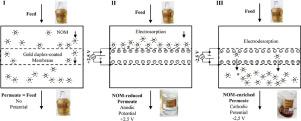Water Research ( IF 12.8 ) Pub Date : 2021-06-01 , DOI: 10.1016/j.watres.2021.117318 Tomi Mantel 1 , Elena Jacki 1 , Mathias Ernst 1

|
Negatively charged electrically conductive ultrafiltration (UF) membranes have been intensively investigated for fouling mitigation and rejection enhancement in recent years. This study reports the novel approach of applying positive charge (+2.5 V cell potential) to a conductive membrane to induce electrosorption of negatively charged substances onto the membrane. Subsequently, desorption of negatively charged substances is achieved by changing the potential periodically (e.g., after 30 min) to negative charge (-2.5 V cell potential). For this purpose, sputter deposition of ultra-thin gold layers (40 nm) is used to generate electrically conductive gold-polymer-gold flat sheet membranes by coating the active and the support layer of two commercial polymer UF membranes (polyethersulfone UP150, polyamide M5). When M5 membrane was charged positively during filtration (+2.5 V), Suwannee River NOM, Hohloh lake NOM, humic acid and Brilliant Blue ionic dye showed removal rates of 70 %, 75% and 93% and 99%, respectively. Whereas, when no potential was applied (0 V) removal rates were only 1 – 5 %. When a positive potential was applied to the active membrane layer and a negative potential was applied to the support layer (cell potential 2.5 V), a significant increase of flux with 25 L/(m² h) was observed due to the induction of electro-osmosis. Electrosorption was only observed for M5 membrane (ζ: +13 mV, pH 7) and not with UP150 membrane (ζ: -29 mV, pH 7). Due to a low current density of 1.1 A/m² at a flux of 100 L/(m² h), the additional energy consumption of electrosorption and desorption process was low with 0.03 kWh per m³ of permeate. This study delivered the proof of concept for the novel process of electrosorptive UF with energy consumption between microfiltration and ultrafiltration but NOM removal rates of nanofiltration membranes.
中文翻译:

通过带正电的导电超滤膜电吸附去除有机水成分
近年来,带负电的导电超滤 (UF) 膜已被广泛研究用于减少污染和提高截留率。该研究报告了将正电荷(+2.5 V 电池电位)施加到导电膜上以诱导带负电荷物质电吸附到膜上的新方法。随后,通过将电位周期性地(例如,30 分钟后)改变为负电荷(-2.5 V 电池电位)来实现带负电荷物质的解吸。为此,超薄金层 (40 nm) 的溅射沉积用于通过涂覆两种商用聚合物超滤膜(聚醚砜 UP150、聚酰胺 M5 )。当 M5 膜在过滤过程中带正电 (+2.5 V) 时,Suwannee River NOM、Hohloh 湖 NOM、腐殖酸和亮蓝离子染料的去除率分别为 70%、75% 和 93% 和 99%。而当没有施加电位时 (0 V),去除率仅为 1 – 5 %。当在活性膜层上施加正电位而在支撑层上施加负电位(电池电位 2.5 V)时,由于电的感应,观察到通量显着增加 25 L/(m² h)。渗透。仅对 M5 膜(ζ:+13 mV,pH 7)观察到电吸附,UP150 膜(ζ:-29 mV,pH 7)未观察到电吸附。由于通量为 100 L/(m² h) 时电流密度为 1.1 A/m²,因此电吸附和解吸过程的额外能耗很低,每立方米渗透液为 0.03 kWh。



























 京公网安备 11010802027423号
京公网安备 11010802027423号